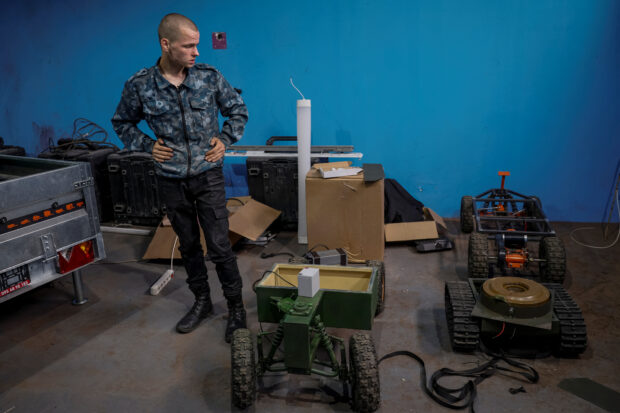Ground vehicles are the new frontier in Ukraine’s drone war

Yevhen Hnatok, 22, former Ukrainian serviceman, shows unmanned ground vehicles he made, in workshop, amid Russia’s attack on Ukraine, in Kyiv region, Ukraine, July 5, 2023. REUTERS
KYIV — After the role of unmanned aerial vehicles in the Ukraine war expanded dramatically since Russia invaded 16 months ago, attention is turning to ground drones that developers say could be the next frontier in military innovation.
Among the Ukrainian engineers working in the sector is 22-year-old Yevhen Hnatok, who said he had already supplied several dozen remote-controlled ground vehicles for the armed forces.
In a recent demonstration, a small green machine with chunky wheels and a landmine strapped to its back moved through long grass almost undetected.
“If they see it at this distance, they won’t even have time to pray,” he told Reuters, referring to Russian forces.
As more experimental technologies are introduced onto the battlefield, small-scale engineers like Hnatok are hoping to influence the war’s outcome with Unmanned Ground Vehicles (UGVs) that carry weapons and explosives or conduct reconnaissance.
Article continues after this advertisementRussia, too, has invested in UGVs including combat robots, and Ukraine wants to counter that, as it has done in the aerial drone sphere, by encouraging innovation among small enterprises.
Article continues after this advertisementHnatok’s machines vary in size and capability: the smaller ones can carry an anti-tank mine or a remotely operated machine gun up to 10 km (6 miles) away from their operator, and he is working on a larger vehicle capable of carrying a 20mm cannon.
Other machines can transport artillery shells to gunners.
The young engineer said the goal was to replace as many troops as possible with machines on the frontlines in order to save lives.
One of the main challenges to Ukraine’s ambitious summer counteroffensive has been the dense networks of anti-infantry and anti-tank mines laid by Russian troops. Losing an expendable UGV to a landmine is preferable to losing a soldier.
One advantage of UGVs is their low cost – the parts for Hnatok’s smaller machines cost less than 30,000 hryvnias ($812).
The impact of combat UGVs from both sides has been extremely limited so far, according to Samuel Bendett, senior fellow at the Center for a New American Security.
However, he said the UGV sector was one to watch, with well-educated and technologically adept volunteers, especially in Ukraine, scrambling to create new vehicles that would give their armies an advantage.
“It’s this type of battlefield innovation at the tactical edge in Ukraine that’s going to (bring about) eventual emerging solutions that can lend themselves to long-term survival in combat.”
Arms race
Ukraine’s community of grassroots defense innovators is a smorgasbord of young IT professionals and older Soviet-educated aerospace and tank engineers. Hnatok, dressed in scruffy black clothes and punk rocker boots, is neither.
The engineer, who only completed nine years of school, said he learnt most of his skills in building remote-controlled vehicles from his stepfather.
“We would build little rockets together, things like that,” he recalled.
Having taken part in combat near Kyiv and in eastern Ukraine in the first months of the invasion, Hnatok decided to start making UGVs in February, after he saw an online post showing off a Russian vehicle.
“I thought: ‘why don’t we start making them?'”
Hnatok said he does not profit from his vehicles, but asks his military buyers to cover production costs.
Combat footage posted online shows how Moscow has already deployed remotely operated versions of old tanks packed with explosives that are sent towards Ukrainian positions.
It is also working on higher-tech, self-driving options such as the Marker UGV, which has demonstrated AI and machine learning capabilities and has been able to traverse through controlled environments without an operator, said Bendett.
Of UGVs more broadly, he added: “The ultimate goal is to have these systems function autonomously in battle … with human operators, UAVs, aerial and manned assets in a networked environment … but we are far from that.”
Hnatok said he was happy to make lots of cheap smaller UGVs, including single-use kamikaze vehicles, but that he would need more staff to fulfill existing orders.
The engineer said he also faced problems with parts supply, with components such as caterpillar tracks now retailing at inflated prices due to a global demand spike caused by the war.
“If before the war a transmitter cost 2,000 hryvnias, it now costs up to 12,000.”
($1 = 36.9290 hryvnias)
RELATED STORIES